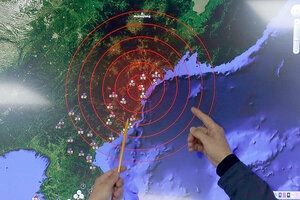North Korea claim of hydrogen bomb test draws global condemnation
North Korea said it had achieved 'perfect success' in a hydrogen bomb test. US geological agencies recorded a 5.1 magnitude seismic event on Wednesday at the reported test site.

Officers from the Korea Meteorological Administration point at the epicenter of seismic waves in North Korea, at the National Earthquake and Volcano Center of the Korea Meteorological Administration in Seoul, South Korea, Wednesday, Jan. 6, 2016. North Korea said it conducted a powerful hydrogen bomb test Wednesday, a defiant and surprising move that, if confirmed, would be a huge jump in Pyongyang's quest to improve its still-limited nuclear arsenal.
Lee Jin-man/AP
Beijing
North Korea announced today it had successfully tested its first hydrogen bomb, a claim that – if verified – is sure to reignite international pressure to check Kim Jong-un’s nuclear ambitions.
Pyongyang issued its announcement after the US Geological Survey and other agencies reported a shallow earthquake near North Korea’s main nuclear test site on Wednesday morning. A news anchor on government-run Korean Central Television said the test was a “perfect success” and involved a “miniaturized” hydrogen bomb.
"North Korea was forced to develop its nuclear arsenal because of the U.S.’s hostile policy against North Korea,” the news anchor said. She added that “as a peaceful nation,” North Korea would not use its nuclear weapons unless under attack.
Amid uncertainty about the purported H-bomb test, which some nuclear experts say was likely an atomic explosion, many of North Korea’s neighbors have reacted with alarm. Japan and the US requested a Security Council meeting to be held Wednesday morning.
Both Russia and China, long-time allies of the impoverished and isolated regime, strongly condemned the test, with Moscow calling it a “gross violation” of international law. In Japan, photographers captured shots of Japan’s defense minister, Gen Nakatani, running to meet with Prime Minister Shinzo Abe. South Korean officials also held an emergency meeting.
US State Department spokesman John Kirby said in a statement that, “We will continue to protect and defend our allies in the region, including the Republic of Korea, and will respond appropriately to any and all North Korean provocations.”
'Nuclear Test Road'
Wednesday’s quake occurred in the northeastern section of the country, near a village called Punggye-ri, that, according to Google Maps, includes a spur called “Nuclear Test Road.”
The site sits about 60 miles east of the border with China, a country that has considerable more leverage over Pyongyang than any other. North Korea conducted successful atomic bomb tests there in 2006, 2009 and 2013.
Youthful North Korean leader Kim Jong-un claimed last month to have developed hydrogen bomb capability, which utilizes fusion technology to allow an explosion up to 1,000 times as large as that of the atomic bombs that the US dropped over Hiroshima and Nagasaki in 1945. Both the US and China have raised doubts about this claim.
For the last decade, Beijing has opposed North Korea’s nuclear tests. Part of Beijing’s calculation is that a nuclear North Korea is an incentive for South Korea and Japan to increase US military assistance in China's sphere of influence.
Last month a short time after Kim boasted of his new nuclear ability, Beijing summarily kicked out a North Korean pop band that Kim had sent for a performance to Beijing in what had appeared to be a diplomatic opening.
While Beijing’s relations with Kim have soured, China remains the principal economic lifeline for North Korea. Along with supplying aid and energy, China buys about $3 billion in goods from North Korea each year.
Mr. Kim, who is thought to turn 33 this week, came to power in 2012 in North Korea’s family dynasty, after the death of his father Kim Jong-il. He has so far not traveled as head of state outside his regime.
Call for new round of talks
At a regular news conference in Beijing on Wednesday, Foreign Ministry spokeswoman Hua Chunying said China has “expressed its firm opposition” to Wednesday's nuclear test.
She also called on North Korea to return to six-party talks – which involve the US, Japan, South Korea, Russia and China – on denuclearizing the Korean peninsula. Such talks have stalled since 2009; the US is reluctant to start new negotiations until North Korea honors past commitments.
According to the US geological agency, today’s 5.1-magnitude quake was the same size as occurred during North Korea’s last nuclear test, in 2013. The wave form also was strikingly similar.
Partly because of that data, many analysts cast doubt that North Korea exploded a true hydrogen bomb, a sign that Pyongyang was steadily advancing its capabilities for deterrence and mass destruction.
Joe Cirincione, a nuclear security specialist who heads the Ploughshares Fund, said in a tweet that North Korea may have exploded a “boosted” fission weapon to create the appearance of an H-bomb. Such a weapon can be made by placing tritium at the core of an atomic bomb to boost its explosive power.
While North Korea has a long history of exaggerating its nuclear capabilities, analysts had anticipated another nuclear test. Satellite photographs analyzed by 38 North, a Washington research institute, suggested that Pyongyang, in recent weeks, was digging a new tunnel at Punggye-ri.
According to North Korea, leader Kim Jong-un ordered the nuclear test on Dec. 15 and signed the final written order on Sunday.

